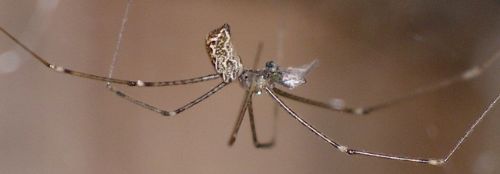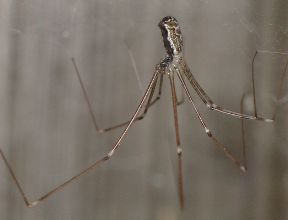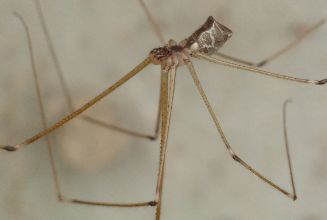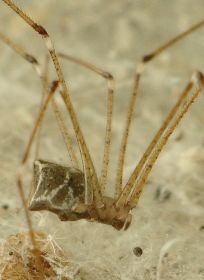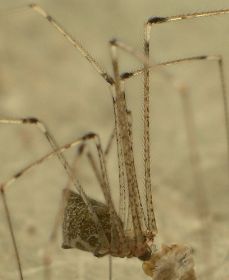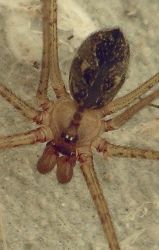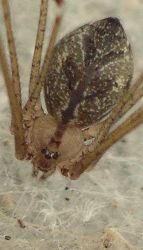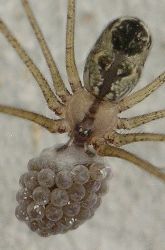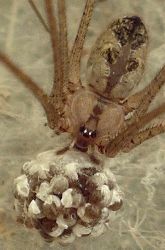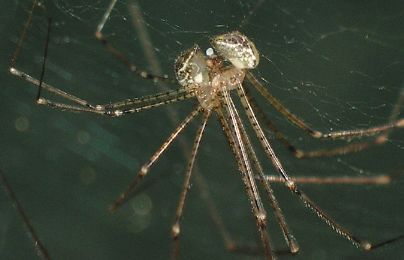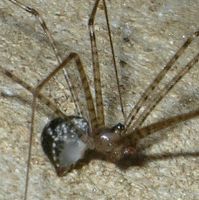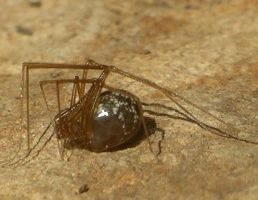
| Pholcidae ~ Cellar Spiders |
|
Cellar spiders, also called daddy-longlegs spiders, are pretty easy to identify to family. They are all small-bodied (usually about 5 mm long) and very long-legged. Imported species are usually found hanging upside-down in messy webs in the corners of buildings, while native species might occur that way or be found under rocks in natural areas. I have found many more individuals of the non-native species, but they are only numerous in scattered areas, probably where conditions are optimum.
The name daddy-longlegs can be confusing, as there is another arachnid group commonly called that. The true daddy-longlegs, or harvestmen (order Opiliones), are not spiders at all, do not produce silk or have venom, and have only one body part, not two distinct sections like spiders. This family is not particularly tolerant of cold and so always occurs inside buildings (especially cellars) in areas with freezing winter temperatures. Here in Austin, the weather is usually mild enough that they can survive outside. That's good for them, since basements are not a standard feature on most houses in Texas. There is an amusing urban legend that claims cellar spiders have the most potent poison of any arachnid, but their jaws are so tiny that they can never bite a person and so this cannot be proven one way or the other. There's a subject for a doctoral thesis.
One of the introduced species that we've had around our house is the marbled cellar spider (Holocnemus pluchei). I suspect some of these hitched a ride on potted plants or perhaps some lumber we bought. I found these spiders in loose, messy webs placed in corners, either along the concrete slab of our house or in the corners of our wooden privacy fence. There were sometimes several individuals all inhabiting one big web, which was probably just their individual webs running into each other. This species has a rather long and cylindrical body, complex brown and white markings and a black belly. The knees of this and most other pholcids that I've found have white marks. When viewed in the shadows, the body and legs almost disappear but the white markings stand out as random dashes. This could be a way to confuse predators. The marbled cellar spider also has a nifty trick it uses when feeling intimidated. It vibrates its web so fast that the spider, bouncing back and forth, actually seems to disappear! While it is quite interesting to see, it is a pain when trying to photograph these little creatures.
The largest species I've found here is Crossopriza lyoni, another introduced arachnid. While its body may be only 5-6 mm long, the legs might span 80 mm. Not found in a lot of places, when it does occur in sheds, garages or other outbuildings, it can be overwhelmingly numerous. A great place for observing these spiders is in some of the buildings at Hornsby Bend Wastewater Treatment Plant, on the east side of Austin. On certain walls, the webs completely cover all surfaces from floor to ceiling. The spiders might hang in the webs or rest on the web-covered substrate, making them easy to observe and photograph. There are sometimes hundreds, from very young to large adults, males and females, and they live in close proximity to each other. As long as there is plenty of prey, the spiders seem to multiply to fill every available bit of real estate. They eat just about anything caught in their webs, including wasps, large jumping spiders, dragonflies, and beetles.
This spider, like the marbled cellar spider, has intricate brown markings on the abdomen. It also has a black belly. The markings are variable, and individuals may be more or less dark vs. light. The abdomen appears rounded in a top view but squared off when seen from the side. There is a dark center stripe on the top of the pale cephalothorax. This might be mistaken for the famous violin shape found on brown recluses, but these spiders are not closely related. Mature males are easily distinguishable from females by the presence of bulbous pedipalps at the front of their face. Both genders are about the same size, which seems to be the case with most cellar spiders.
I've also been able to observe the eggs of this species, which the female holds in her chelicerae (fangs). She uses very little silk to bind the eggs into a ball, so they are clearly visible. She continues to hold the mass, even after the eggs hatch. The babies at this stage (which in some species would still be inside a silk sac) are feeding off their egg yolks, and are not yet capable of moving around or feeding themselves. They will molt and then be ready to head off for independent life as little miniatures of the adults. When cellar spiders mate, their tiny bodies seem to merge together (the male's pedipalps are pretty darn short so they have to snuggle up close to get the job done) and there are a whole lot of legs sticking out! In the photo of an unidentified species shown here, it is possible to see the little white globule of sperm that the male is transferring to the female.
One species, Modisimus texanus, in this family has a very distinctive, if tiny, feature: the eyes are grouped together on a short stalk at the top of the cephalothorax. This is a very small spider, with an abdomen that seems to curve around in a tight C-shape, ending with a little point. The cephalothorax and legs are brownish but the abdomen is dark with many tiny white spots. This is a native species and I've found it hiding under rocks.
Another pholcid has an even more curved abdomen than the previous one, the tip ending up just about under the base of the spider's rear legs. This is probably a Psilochorus species. It appears so round and shiny that, when the spider is in its defensive curled up position, it might appear to be a cobweb weaver, but the long and very spindly legs should correct that assumption. This one also occurs under rocks, and is about 3-4 mm long. |
![]()
